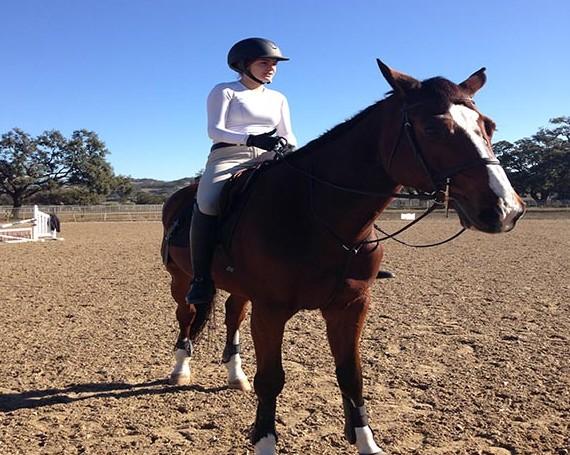Girls get serious about sports — they are not just horsing around
Grabbing the reigns on a big commitment
December 10, 2015
An under-recognized group of elite athletes is spending an average of 24 hours a week learning to coax their 1100 pound teammates into maneuvering jumps and obstacles.
“Horses don’t understand hopes or aspirations — only clear direction,” junior Bettina Giglio, who has been riding horses for 11 years, said.
Student equestrians compete in equitation, jumper and dressage disciplines. These different divisions allow riders to focus on different skills and variables.
Giglio competes in the equitation division in all the horse shows she attends.
“The purpose of the equitation division is to mold better jumper-riders,” Matt Sereni, Head Trainer at Sterling View Farms, said. “Equitation is supposed to be the foundation for riding.”
The circumstances upon which a competitor is judged vary and are decided by each competition separately.
Equitation riders can be judged both over fences and on the flat, the arena environment equipped with jumps and fences. Riders can be judged not only on their ability to negotiate a course of jumps on their horses, but also on their style and position while they do it, demonstration of understanding, execution, consistency, accurateness and style, according to The United States Equestrian Federation.
“For me personally, equitation hurt my confidence a little bit,” junior Lauren Kee said. “There would be these girls on these $250,000 horses — because they can afford that — and I would be on my cheaper horse, and sometimes you just can’t compete with that.”
Kee tried equitation but switched back to the jumper faction of competition.
“If you have a good-minded horse that trusts you, you can still beat the people that just buy their way to the top,” Kee said.
The show jumping course tests a horse’s athleticism, agility and tractability while simultaneously testing a rider’s precision, timing, accuracy and responsiveness on an obstacle course of jumps meant to stay intact throughout the run, according to USEF.
“The jumper faction is a lot more based on what you dare to do, and your time,” Kee said. “Nobody can argue with it because it’s just based against a clock.”
Each horse show has a different set of qualifications required to compete.
“At the minimum, you have to win the corresponding final class at a local horse show in order to be qualified to go to one of those horse shows,” Sereni said. “They don’t want you at the finals if you aren’t good enough to be there.”
Giglio plans to attend the HITS Thermal Desert Circuit for four weeks during March and April in Southern California.
Success at horse shows depends on her ability to replicate her peak performance during the two minutes she is given in the show ring, according to Sereni.
“Bettina and her horse Zag can function as a team and very much accomplish the goals that she has set for herself,” Sereni said.
Giglio pledged to participate in a month free of irons called No-Stirrup November, which will increase the strength of her leg muscles.
“It’s basically like a football player hitting the weight room extra hard in the off-season,” Sereni said. “This is our off-season, and then we hit the ground running again on Feb. 15, but right now she’s basically hitting the weight room.”
Riders learn the responsibility of taking care of and building a relationship with another being.
“I’m very insistent on building a relationship and not just riding,” sophomore Francesca Petruzzelli said about her horse, “He’s like my best friend.”
Each barn visit includes flatwork, riding, care and clean up. Flat work entails stretching the horse’s muscles, preparing and dressing the horse and the rider in the proper gear such as saddles, bridles, boots, irons and bits.
“Stretching out the horse’s legs and neck, much like stretching for running, is very important so that their muscles are warmed up,” Petruzzelli said. “Pulling something is a big worry.”
Warm-ups with horses are similar to human athlete warm-ups and are meant to engage the back and hind muscles of the horse to ensure better jumps.
“Riders are learning to deal with the good kids out at the shows and with the little brat kids,” Sereni said. “It’s about walking into the show-ring environment and having tunnel vision, focusing on that it’s just you and your horse out there, and blocking out everything else, whether it’s personal, whether it’s family, or school.”
The year a rider is 17 to 18 is the last year she is eligible for competition as a non-professional, increasing the importance of that time.
“I’m not trying to overvalue the importance of the junior years,” Sereni said. “There’s a lot of riding past that, by no means is it over, but they’re precious.”
Riding requires a diligent work ethic and a positive outlook on failure and success, according to Sereni.
“It makes my job a lot easier when the riders really want to work,” Sereni said. “Like any other sport, it teaches the competition factor of sportsmanship. It teaches losing with grace, and winning with modesty.”
Apart from what she learns in terms of responsibility, Giglio attributes her communication skills to what she has learned from riding.
“I think that one of the coolest things about riding is just learning to speak their language because in the end it’s a team thing and you’re not just gonna get your way by demanding of the horse,” Giglio said. “The horse has to feel invited to do the work, it has to want to do the work. They’re bigger than you, they’re stronger than you, you cannot force them to do anything.”

